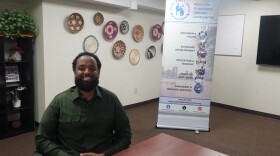Sometimes rare diseases can let scientists pioneer bold new ideas. That's been the case with a condition that strikes fewer than 100 babies a year in the United States. These infants are born without a functioning immune system.
The disease is called severe combined immunodeficiency, or SCID. "It was made famous in the mid '70s when the 'Bubble Boy' was described in a documentary, and I think it captured the imagination of a lot of people," says Matthew Porteus, a pediatrician at Stanford University.
David Vetter was the boy who spent most of his short life inside a plastic bubble to protect him from infection. He died at the age of 12 in 1984.
All babies born in the United States are now screened for this condition, and the best treatment today — a bone marrow transplant — succeeds more than 90 percent of the time. The disease remains a source of great interest to researchers.
"This is one of those diseases in which there's probably more doctors and scientists studying the disease than patients who have the disease," Porteus says.
In the 1990s, European scientists actually cured SCID in some patients, using a technique called gene therapy. This process involves removing defective blood cells from a patient, inserting a new gene with the help of a virus, and then putting the cells back into the body. Those cells then build up the patient's immune systems.
At first this treatment in the 1990s and early 2000s looked really promising.
"Of the 20 patients, they all had immune recovery," says Donald Kohn, an immunologist at UCLA's Broad Center of Regenerative Medicine and Stem Cell Research. "But, over time, five of them went on to develop a leukemia."
He says 18 of those original patients are still alive today, but the incident put an understandable pall on the whole field of gene therapy.
Scientists went to work to figure out how to inject new genes into cells without triggering leukemia, a cancer of blood cells. And they think they've succeeded.
Since then, there has been gradual improvement in gene therapy. The latest advance, reported in the New England Journal of Medicine Wednesday, details a study of eight infants who have a type of SCID called SCID-X1.
The gene to correct the problem was inserted into a modified version of HIV, the virus that causes AIDS. That engineered virus can't cause AIDS and it's been further tweaked to reduce the risk that it could trigger leukemia.
Gene therapy has been used successfully over the past decade. Scientists at St. Jude's Children's Research Hospital in Memphis modified the procedure for SCID by giving the infants a short course of chemotherapy before introducing the new gene. This helped the new cells take up permanent residence. The babies developed apparently healthy immune systems, according to the new study.
"I am thrilled to see these outstanding results," says Ewelina Mamcarz, a transplant physician and first author on the new paper.
"To be able to see these babies in my clinic now as toddlers is very rewarding," she says. "They live normal lives. They aren't any different from my daughters." Two more infants have been treated since the paper was prepared for publication, the team says.
Standard treatment for SCID is a bone marrow transplant. But that procedure often restores only part of a child's immune system. As a result, patients require monthly infusions of antibodies called immunoglobulins. Jennifer Puck, a pediatrician at UC-San Francisco and a collaborator in the latest study, says infants who got the gene therapy don't need that medication.
These children are "growing normally, they're getting colds like everyone else and they're getting over infections — so I would say that is a cure," Puck says.
Of course, she adds, they'll be watched carefully for signs of leukemia and to see if the effect of the therapy is wearing off.
In her view, the key to treatment is finding these children early — through newborn screening — before they start to get life-threatening infections. Screening for SCID is now done through the U.S., though its introduction was gradual, and state-by-state.
Before screening was instituted, these children used to show up in the hospital with life-threatening infections, "and now we're seeing happy, bouncy little newborns who just look perfectly normal and they're never sick," Puck says. "Sometimes their families don't understand just how profoundly affected their immune system is."
St. Jude's hopes to commercialize its treatment. It has an exclusive licensing agreement with Mustang Bio to develop a product. A similar treatment, called Stremvelis, has already been approved by Europe's equivalent of the Food and Drug Administration. It targets a different mutation that causes SCID, but the technique is very much the same, including the brief dose of chemotherapy.
This latest advance is not only encouraging news for these rare patients. SCID is a test case for all those scientists working to develop better gene therapy techniques.
For example, instead of inserting a healthy gene into blood cells, Matt Porteus at Stanford has used a precision gene-editing technique called CRISPR to correct the genetic error in SCID blood cells drawn from people. It works in the laboratory, "and this really sets the stage, then for a clinical trial, hopefully in the next 12 to 18 months," he says.
All this makes the leukemia setback from the 1990s feel like a fading memory. Kohn at UCLA says for more than a decade, it seemed that the field of gene therapy was a dead end.
Clearly it has made a comeback, and has treated other rare diseases, including adrenoleukodystrophy, a neurological condition better known as "Lorenzo's Oil" disease, after a 1992 movie that highlighted a boy with the condition, and his parents' hunt for a cure.
Now, with continual advances in treating SCID, "it's just nice to see another success for gene therapy," Kohn says.
You can contact NPR Science Correspondent Richard Harris at rharris@npr.org.
Copyright 2019 NPR. To see more, visit https://www.npr.org.






